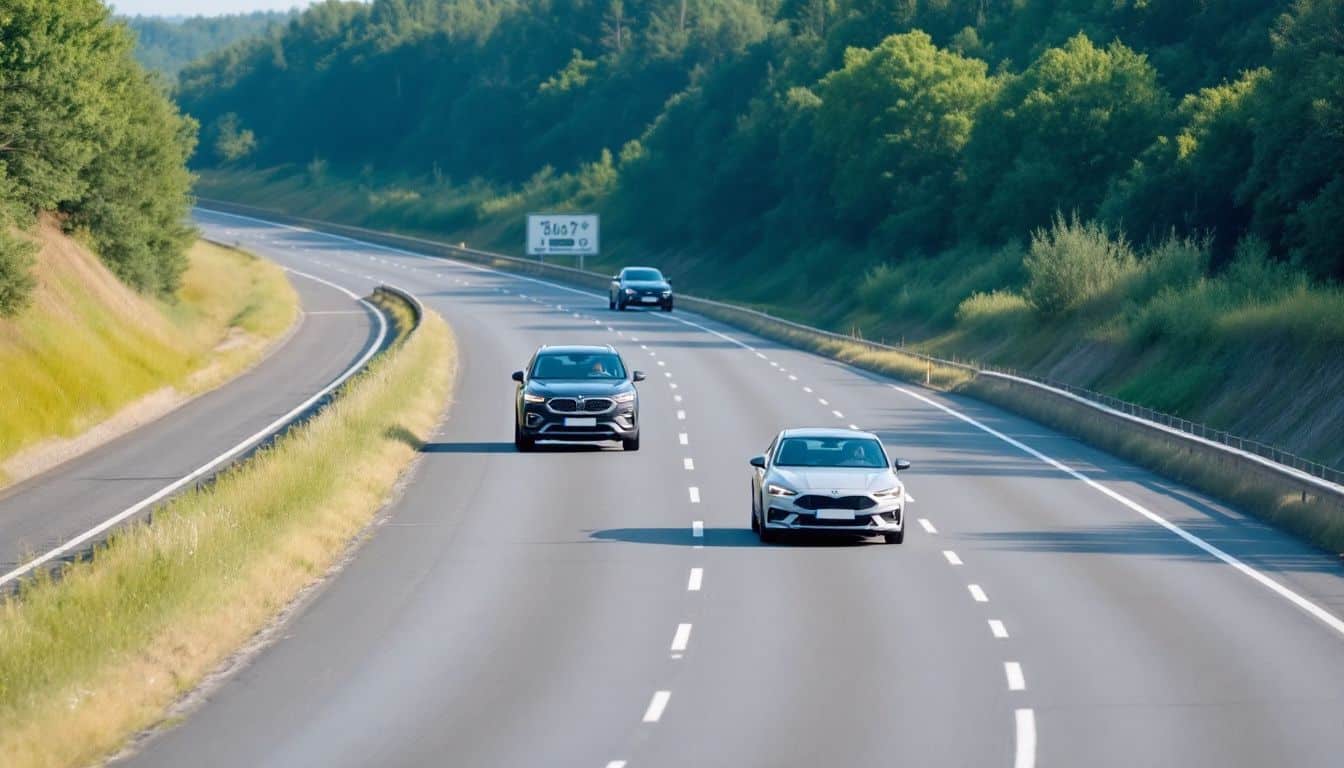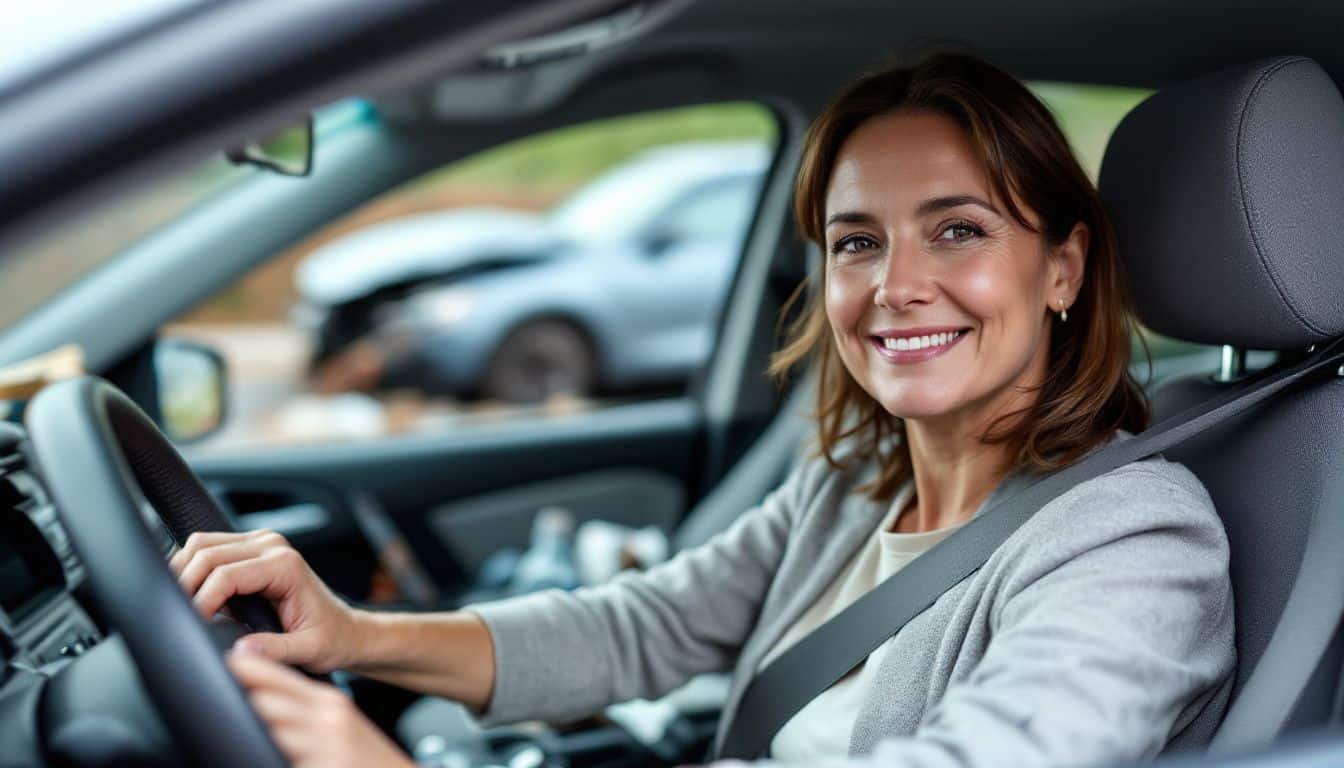Car crashes can happen to anyone, anytime. Each year, over 6 million accidents occur in the U.S. alone. This guide will arm you with 15 crucial tips to boost your chances of survival.
Ready to learn how to survive a car crash? Let’s roll!
Key Takeaways
Pick a safe car with good crash test ratings and features like airbags and anti-lock brakes. SUVs offer better protection but check IIHS ratings too.
Always wear your seatbelt. It cuts your risk of dying in a crash by 45% in cars and 60% in light trucks.
Keep a safe distance from other cars using the two-second rule. This gives you time to react if something goes wrong.
In bad weather, slow down and increase your following distance. 25% of all car crashes happen in poor weather conditions.
After a crash, check for injuries, call 911 right away, and take photos of the scene for insurance purposes. See a doctor even if you feel fine, as some injuries may not show up right away.
Table of Contents
Essential Preparations for Surviving a Car Crash

Getting ready for a crash isn’t fun, but it’s smart. You’ll want to pick a safe car and use your seat belt right – it’s a no-brainer.
Selecting the Safest Car for Crash Survival

Picking a safe car is key to surviving crashes. Big, heavy cars like SUVs offer better protection in accidents. They’re less likely to roll over and can take more impact. But don’t just go by size.
Check crash test ratings from IIHS before buying. They test cars each year and name the safest ones. For 2024, some top picks are the Acura Integra, Toyota Prius, and Honda CR-V.
Safety features matter too. Look for cars with side airbags, anti-lock brakes, and lane-departure warnings. These can help prevent crashes or reduce harm if one happens. I once test-drove a car with automatic braking – it stopped on its own when a kid ran into the street! That’s the kind of tech that saves lives.
And don’t forget about top cars for men – they often have great safety ratings too.
The safest car isn’t always the biggest – it’s the one with the best crash test scores and safety tech.
Implementing Proper Seat Belt Usage

Now that you’ve picked a safe car, let’s talk about seat belts. They’re your best friend in a crash. In 2017, seat belts saved nearly 15,000 lives. That’s huge! But here’s the kicker – half of the people who died in car crashes in 2022 weren’t buckled up.
Yikes!
Buckle up every time you get in the car. No excuses! The national seat belt use rate hit 91.9% in 2023. That’s great, but we can do better. Don’t forget about the kids. They need special seats until they’re big enough for regular belts – usually between 8 and 12 years old.
Wearing a seat belt cuts your risk of dying in a crash by 45% in cars and 60% in light trucks. Those are odds you can’t ignore. So click it or ticket, folks!
Equipping Your Vehicle with Necessary Safety Features
Proper seat belt use is crucial, but it’s not the only safety measure. Your car needs the right gear to keep you safe. Here’s what you should have:
- Airbags: These lifesavers are a must. They pop out in crashes to cushion you. Most new cars have them in the front and sides.
- Anti-lock brakes (ABS): These stop your wheels from locking up when you brake hard. You keep control and can steer away from danger.
- Tire pressure monitors: They tell you when your tires are low on air. This helps prevent blowouts and keeps your car stable.
- Child safety seats: If you have kids, get LATCH-compatible seats. They’re easier to install right and keep little ones secure.
- Forward collision warning: This system alerts you if you’re about to hit something. It gives you time to brake or swerve.
- Automatic emergency braking: If you don’t react to the warning, this system brakes for you. It can prevent crashes or make them less severe.
- Rearview camera: This helps you see what’s behind your car. It’s great for backing up safely and avoiding obstacles.
- Headrests: They’re not just for comfort. Headrests prevent whiplash in rear-end crashes. Make sure they’re adjusted right.
- First aid kit: Keep one in your trunk. It’ll come in handy for minor injuries after a crash.
- Fire extinguisher: Cars can catch fire in bad crashes. A small extinguisher could save lives.
Driving Practices to Reduce Car Crash Risk

Staying safe on the road isn’t rocket science. It’s all about smart moves and keeping your cool – even when other drivers are acting like they’ve lost their marbles. Let’s dive into some tricks that’ll help you dodge those nasty fender-benders and keep your ride in one piece.
Adhering to Speed Limits and Traffic Signals
Speed limits and traffic signals aren’t just suggestions. They’re life-savers. Sticking to posted speeds gives you more time to react if something goes wrong. It also cuts down on how far you need to stop.
Traffic rules exist to keep everyone safe on the road. Breaking them puts you and others at risk.
Speeding is a big no-no. It’s one of the main reasons car crashes happen. When you speed, you have less time to spot danger and act. Your car also needs more space to stop. Fast driving is part of aggressive behavior on the road.
This kind of driving leads to many wrecks. Next, let’s look at how to keep a safe distance from other cars.
Keeping a Safe Distance from Other Vehicles

Now that we’ve covered speed limits, let’s talk about space. Keeping a safe distance from other cars is key. It’s like giving yourself a safety bubble on the road. This bubble gives you time to react if something goes wrong.
Think of it as a two-second rule. Pick a spot on the road ahead. When the car in front passes it, count “one-thousand-one, one-thousand-two.” If you reach that spot before you finish counting, you’re too close.
Back off a bit. This rule works at any speed. It’s a simple way to avoid a car accident settlement down the road.
Plus, it cuts down on tailgating – a big no-no for safe driving.
The space between you and the car ahead is your safety net on the road.
Navigating Safely During Adverse Weather Conditions

Bad weather can make a simple drive risky. Rain, snow, and ice make roads slippery and hard to see. Did you know that 25% of all car crashes happen in bad weather? Most of these are on wet roads.
To stay safe, slow down. Going from 60 mph to 40 mph cuts your stopping distance by more than half.
Your car needs extra care in rough weather too. Check your tires, wipers, and fluids often. Good tires grip wet roads better. Clear wipers help you see through rain and snow. And the right fluids keep your car running smoothly.
In light rain, you need twice the space to stop. In snow, you need four times as much. Stay alert, drive slowly, and keep your distance from other cars. These simple steps can save your life on stormy days.
Recommended Actions During a Car Crash

When the rubber meets the road, knowing what to do can be a lifesaver. Buckle up – we’re about to dive into the nitty-gritty of crash survival… and trust me, you won’t want to miss this!
Utilizing Anti-Lock Braking Systems Effectively

Anti-lock braking systems (ABS) are a game-changer in car safety. They stop your wheels from locking up when you hit the brakes hard. This means you can still steer while braking – super helpful in wet or icy conditions.
But here’s the thing: you need to use ABS right to get the most out of it.
ABS is like having a co-pilot for your brakes. It’s there to help, but you still need to know how to work with it.
To use ABS well, press the brake pedal firmly and don’t let up. It might feel weird at first – the pedal may vibrate or pulse. That’s normal! Just keep pressing and steer around danger.
ABS works best on wet roads, but it might take longer to stop on loose surfaces like gravel. Keep in mind, ABS is there to help you keep control, not to stop faster.
Executing Maneuvers to Minimize Impact
Fast thinking can save lives in a crash. Direct your car toward things that’ll cause less damage. Go for bushes or a snowbank instead of a solid wall or tree. If you’re about to hit another car, try to make it a glancing hit rather than head-on.
This can spread out the force and reduce the impact.
Your car’s features can help too. Anti-lock brakes stop your wheels from locking up, so you can still direct while braking hard. Don’t pump these brakes – just press down firmly and hold.
If you start to skid, look and steer where you want to go, not at what you’re trying to avoid. It might seem strange, but it works! I once avoided a bad pile-up by using these tips.
Believe me, they can make a huge difference when seconds matter.
Assuming a Protective Position During a Crash
Heads up! Your body position during a crash can really matter. Sit straight, back against the seat, feet flat on the floor. This helps airbags do their job better and lowers injury risk.
For top safety, buckle up and go for the middle rear seat – it’s usually the safest spot in cars.
If you’ve got a moment to react, grab the wheel at 9 and 3, then relax your arms. Tuck your chin to your chest to protect your neck. If you’re not driving, cross your arms over your chest and lean forward a bit.
These moves can help you handle the impact and avoid flying objects. Every second’s important – so stay sharp and ready to protect yourself!
Steps to Follow Immediately After a Car Crash
Crash! Your heart’s racing, and you’re in shock. But what you do next could save lives – maybe even your own. Let’s dive into the crucial steps you need to take right after a car wreck.
Assessing and Addressing Injuries
After a crash, check yourself and others for injuries right away. It’s crucial for your safety and for insurance claims. Look for cuts, bruises, or any pain. If someone’s hurt badly, don’t move them unless they’re in danger.
Call 911 fast if there are serious injuries.
Even if you feel fine, see a doctor soon after a car crash. Some injuries, like whiplash, might not show up right away.
A doctor’s visit creates a record that can help with insurance or legal issues later. Your health comes first, so don’t skip this step!
Safety isn’t expensive, it’s priceless. – Unknown
Contacting Emergency Services Promptly
In a car crash, every second counts. Don’t wait – call 911 right away. Quick action can save lives. Tell the operator where you are and what happened. Be clear and calm. They’ll send help fast.
If you’re hurt, stay put. Let the pros check you out. Even if you feel okay, hidden injuries might lurk.
Calling emergency services does more than get help. It creates an official record. This matters for insurance claims. It also helps figure out who’s at fault. The police report is gold for your case.
So, grab your phone and dial those three magic numbers. Your future self will thank you.
Exiting the Vehicle Safely When Required
Leaving your car after a crash can be tricky. You need to think fast and stay safe. First, check if it’s okay to get out. Sometimes, staying in is safer. But if you smell gas or see smoke, get out fast! Move away from traffic if you can.
Don’t rush – take a deep breath and look around first.
If you must exit, be careful. Unbuckle your seat belt and check for injuries. Look out for broken glass or sharp metal. Open the door slowly, watching for other cars. If the door won’t open, try the windows.
Once out, move to a safe spot away from the road. Don’t forget to grab your phone if you can. Next, we’ll talk about what to do right after you’re safe from the crash.
Managing the Aftermath of a Car Crash
After the dust settles, you’ve got a whole new set of challenges. Dealing with insurance, medical bills, and maybe even legal issues can feel like a second crash – but don’t worry, we’ve got your back.
Communicating with Other Affected Parties
After a crash, talking to others involved is crucial. Stay calm and polite. Get names, phone numbers, and insurance info from all drivers. Don’t forget to speak with any witnesses too.
Their accounts can help your case later. Write down what they saw or heard – it might be useful.
Be careful what you say, though. Don’t admit fault or apologize. Stick to the facts. If the other driver seems angry, keep your cool. Safety first! If you feel threatened, stay in your car and call 911.
Good communication now can save you trouble later on.
Recording the Accident Scene for Insurance Purposes
Grab your phone and start taking pictures! Photos are super helpful for insurance claims. I found this out after my minor accident last year. Take shots of all car damage, road signs, and skid marks.
Make sure to get pictures of the whole scene too. These photos will really help when you’re talking to insurance people.
Then, write down important info. Get names and contact details of everyone involved. Write what happened while you remember it clearly. And here’s a tip – don’t say it was your fault! Let the experts figure that out.
Believe me, you’ll be glad you were thorough later on. It might seem annoying now, but it’ll make things easier in the future.
Attending to Health Concerns Post-Crash
After a crash, your health is crucial. Don’t ignore any pain or discomfort. Even if you feel okay, see a doctor quickly. Some injuries, like whiplash or internal bleeding, might not be obvious right away.
Your body’s been through a shock, so give it time to recover.
Mental health is important too. Car crashes can be emotionally difficult. You might feel scared, angry, or sad – that’s normal. If these feelings persist, talk to someone. The ADAA has helpful info on managing post-crash stress.
It’s okay to need help. Your well-being is the priority, so take care of yourself both physically and emotionally.
People Also Ask
How can I avoid a car crash?
Stay alert and dodge distracted drivers. Keep your eyes peeled for danger. Follow the two-second rule to maintain a safe distance. Brush up on your skid control skills. And remember, your anti-lock brake system is your friend in a pinch.
What should I do if a crash is unavoidable?
Brace yourself! Grip the wheel at 9 and 3. Hit those brakes hard. Aim for something soft if you can. Avoid head-on collisions like the plague. And for Pete’s sake, keep those seatbelts snug!
How can I protect myself during a crash?
Your safety belt is your knight in shining armor. Buckle up, buttercup! Make sure that lap belt is low and tight. Keep loose items in check – they turn into nasty projectiles. And don’t forget to adjust your headrest to prevent whiplash.
What should I do after a crash?
First things first, check for injuries. If you’re okay, help others if you can. Call 911 pronto. Snap some pics for your insurance claim. And if you smell something funky, get out fast – flammable goods are bad news.
How can I prepare my car for better crash survival?
Give your ride a safety makeover. Check out those Euro NCAP ratings when car shopping. Keep your vehicle in tip-top shape. And for heaven’s sake, ditch the clutter on your dashboard. It’s not a storage unit!
What should I know about different types of crashes?
Multi-car pileups are a whole different ball game. In rollovers, brace yourself and hang on tight. For side impacts, lean away if you can. And in bus accidents? Find an exit strategy, pronto. Knowledge is power, folks!
References
References
- https://www.quantrellcollision.com/best-cars-for-surviving-an-accident/
- https://wewin.com/surviving-a-crash/ (2023-09-22)
- https://www.nhtsa.gov/vehicle-safety/seat-belts
- https://www.gjel.com/blog/the-life-saving-benefits-of-wearing-a-seatbelt
- https://www.consumerreports.org/cro/2012/04/guide-to-safety-features/index.htm
- https://www.gjel.com/car-accident-lawyers/tips-to-prevent-car-accidents
- https://accidentcare.com/20-ways-to-prevent-a-car-accident/
- https://www.mayorlaw.com/top-10-tips-driving-safely-bad-weather-conditions/
- https://www3.safetyserve.com/articles/driving-with-abs/
- https://premierinjuryclinicsofdfw.com/best-position-to-be-during-a-crash/
- https://falklawyers.com/7-steps-you-should-take-immediately-after-a-car-accident/
- https://yourhealthmagazine.net/article/legal-and-health/what-to-do-immediately-after-a-car-accident-a-step-by-step-guide/
- https://dawsonlawfirm.com/7-important-steps-you-must-take-immediately-after-a-car-crash/
- https://kidshealth.org/en/teens/post-crash.html
- https://appsychology.com/car-crashes/ (2023-08-20)
- https://www.aarp.org/auto/driver-safety/what-to-do-after-car-accident/ (2021-06-21)
- https://adaa.org/learn-from-us/from-the-experts/blog-posts/consumer/how-cope-trauma-after-accident (2019-11-26)

